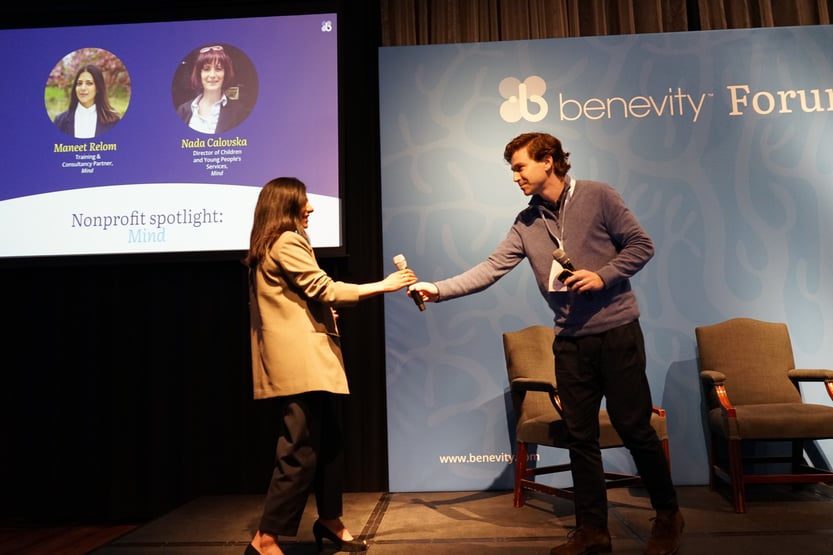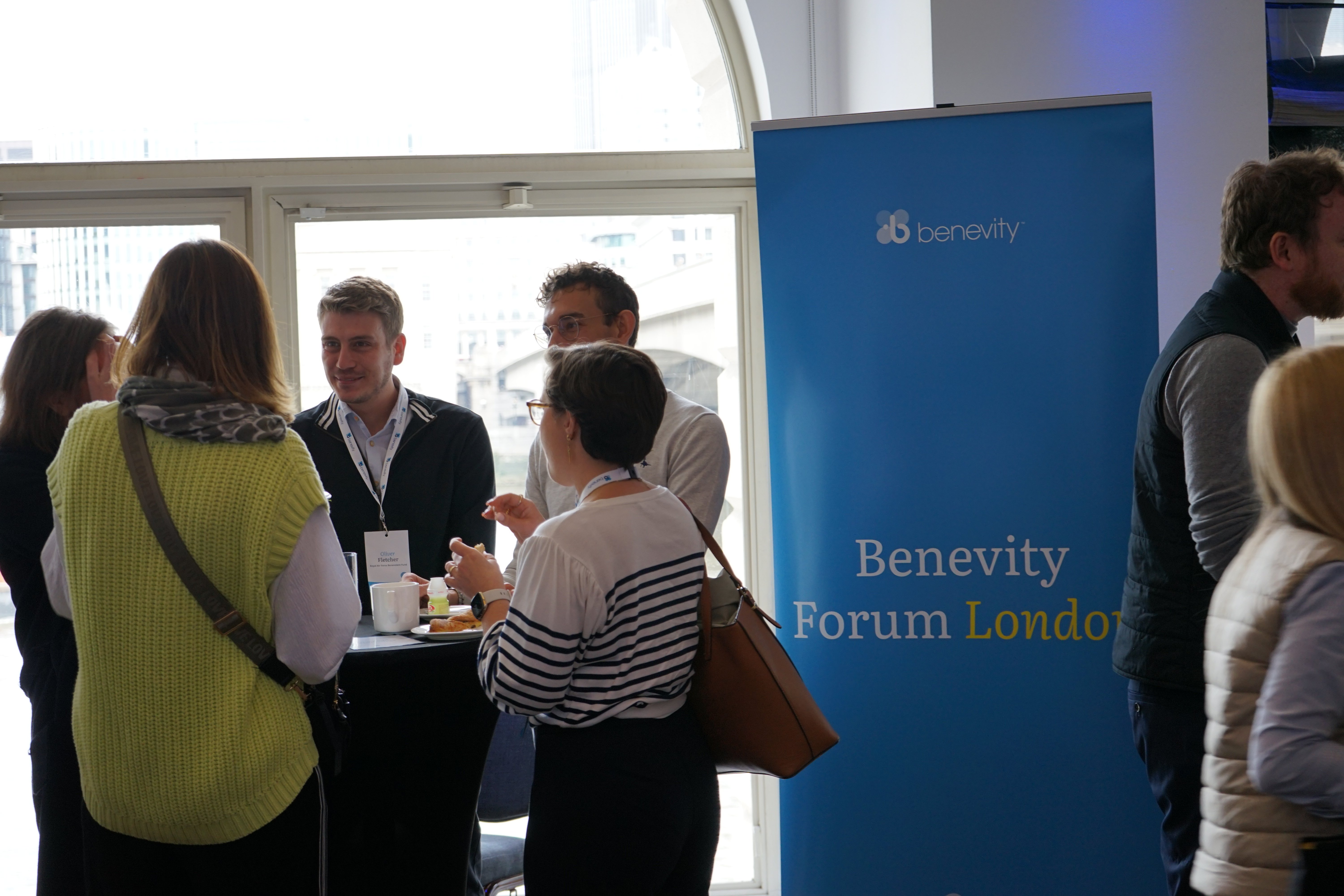Cultivating a needs-based approach to strategic nonprofit partnerships

Strong nonprofit partnerships address the needs and challenges that organisations are facing on the ground. This shift away from traditional philanthropy and towards approaching social impact via the specific needs of nonprofits was a key topic of conversation at the Benevity Forum London.
Katie Fitzpatrick, Associate Director – Global Partnerships Engagement at Novartis, shared her perspective on the topic in a special presentation on Novartis’ nonprofit partnership strategy.
The pillars of a successful needs-based partnership strategy
With an increasing focus on creating sustainable impact, evidence suggests that a needs-driven, skills-based approach can have more benefits than more generic volunteering or fund donations.
This is why Novartis has built a partnership methodology and framework that works to pinpoint community deficits and provide support based on the real needs of partner organisations.
During her presentation, Katie walked us through the steps that led them to building their powerful needs-based approach to strategic nonprofit partnerships.
From legacy partnerships to strategic partnerships
When it comes to partnerships with nonprofits, Katie believes it’s essential to look beyond legacy associations and focus on strategic collaborations.
For 25 years, Novartis hosted a Community Partnership Day. While popular, this event was often a “show up, show off” model that wasn’t fulfilling the company’s potential when it came to making a real difference.
Instead of simply donating to organisations, the focus became on asking questions like: “Why are we partnering with this nonprofit? Why now? How can we leverage employee skills and know-how to make a real, tangible difference?”
Many companies have nonprofits that you've been donating to for years – but these are really more like legacy nonprofit partners. It's important to make sure that it's not just legacy; it's a partnership and not a transaction.
Katie Fitzpatrick , Associate Director – Global Partnership Engagement at Novartis
A more selective approach means that partnerships are more beneficial and based on shared goals. By prioritising the needs of the community and actively listening to nonprofits, companies can forge stronger, more impactful relationships.
But in order to understand these shared goals, it’s crucial to better define how impact is measured.
Measuring impact: A holistic model that goes beyond numbers
Impact evaluation is key to understanding the real impact of corporate giving. Often, statistics such as the number of volunteers or number of hours are simply vanity metrics which don’t accurately represent the scale or quality of the work being done.
Novartis recognised that a shift in perspective was needed. That’s why, instead of measuring hours, they decided to examine the impact created by each individual. To do this, they work with an impact valuation model which looks at the impact on people, partners, the company and society. Having developed this IOOI (input-output-outcome-impact) model, they incorporate financial terms and quality-adjusted life years to calculate the social return on investment.
This data-driven approach has yielded some incredibly useful insights. The emerging data suggests that skills-based volunteering generates more sustainable outcomes than traditional hands-on tasks, like painting a classroom or picking up rubbish.
With this knowledge, Novartis decided to focus on channelling the diverse skills and expertise of their employees to maximise their societal impact.

Making a real difference with purpose-driven initiatives
Implementing a needs-based approach at a local level required a two-pronged approach: individual and team engagement.
At Novartis, they developed a partnership toolkit that empowers individuals to propose new nonprofit partners, evaluate them and then manage those partnerships.
This approach ensures that local perspectives are embedded in the volunteering strategy – and it permits an easy integration of new nonprofits into the company’s ecosystem.
We don't want to be pitched an idea just because it's flashy and we don't want to pay to play. We want to have a conversation, a discovery and to understand how we can complement each other.
Katie Fitzpatrick , Associate Director – Global Partnership Engagement at Novartis
The move from a philanthropic approach, which involved donating funds or medicine, to a more impactful model has yielded impressive results. This has been exemplified through their refugee response and Leprosy programme, where Novartis provided holistic support initiatives such as volunteering, training, education and even housing for refugees.
By leveraging employee skills, they developed innovative solutions like an Airbnb-style housing platform for refugees. Their impact measurement model indicated that this kind of skills-based volunteering created the most significant impact, generating a 4.5x social return on investment.
Katie highlighted another example of their partnership with a Leprosy centre in Hyderabad, India. By conducting a needs assessment and engaging volunteers from various backgrounds, Novartis developed the world’s first cloud-based Leprosy data lake, revolutionising patient records management.
All of this work has enabled them to further embed employees and their skills into these relationships with nonprofits, deepening their partnerships and ability to make a difference.

Making the most of the available expertise
Over time, Novartis has found that matching specific needs with the appropriate skills and expertise has proven to be a much more effective way of allocating company resources to make a real, tangible difference.
You don't hire a pilot to clean the wheels of the plane. You hire a pilot to fly the plane.
Katie Fitzpatrick , Associate Director – Global Partnership Engagement at Novartis
Katie continued, “For a lot of these manual, hands-on activities you're using leaders in all these different, amazing areas, and yet you're asking them to do a marathon or to paint a classroom or to plant seeds. It’s not necessarily a bad thing, because that has impact and that's team building. It's important. But imagine how much more you can do with the expertise and the know-how.”
Finally, there’s no limit on the number of hours that employees can volunteer – and the programme is open to retirees, family and friends.
They use a wide volunteer pool, opening up resources and skills to apply to a volunteering context. At Novartis, corporate volunteering is an opportunity for employees to both use and, crucially, develop their skills on company time.
Unlocking the true power of volunteering
For meaningful change to take place, there needs to be a strategy in place that has two, clear points:
- The specific needs of the nonprofit
- The specific skills needed to address them
Here were some of her other top tips for developing a similar strategy:
- Communicate directly with the nonprofit to ascertain their needs
- Active listening is key to constructive communication
- Maintain a fair and balanced framework for employees to support nonprofits
- Look beyond the numbers to measure real impact
With trailblazers like Novartis leading the charge for needs-driven and skills-based volunteering, real change is starting to happen, with the results to prove it.
Often, it’s not about a company’s size or resources when it comes to the scale of impact they can deliver, but rather how they use and allocate these resources. It’s a question of quality, not quantity. Whether it’s expertise, manual skill or industry knowledge, efficient volunteering is about applying these where they’re needed most.
Keeping a pulse on future CSR and ESG trends
Our Benevity Forum events play a pivotal role in revealing regional trends that we know will impact the future of doing good. Keep an eye out for future learnings coming from upcoming forums in London, Paris, Frankfurt and Zurich, and of course our annual Benevity Live! event. You won’t want to miss these insights from the world’s most purpose-driven brands!
